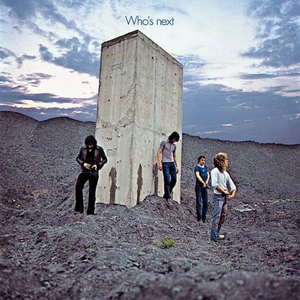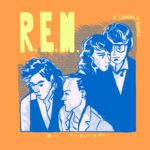“The story that lay behind this batch of songs… was supposed to be probably the most ambitious concept that I had worked on. Ever!”
Who’s Next, was The Who’s fifth studio album, released by Track Records in August 1971. It had started as an idea Pete Townshend had for a concept album that would then spiral into a million dollar film. Titled Lifehouse, it was an ambitious project that was to enable the band to build on the success of the rock opera, Tommy, but which very nearly unravelled its creator.
“It was a story, around which I wrote some songs,” Townshend would say later during a radio interview. “And the story was… A bit like Close Encounters, or E.T.” When the project was eventually abandoned, everyone apart from Townshend scratching their heads in confusion at the story and its meaning, all that was left was 8 songs. 8 songs that, along with John Entwistle’s ‘My Wife‘, would form Who’s Next, the band’s most critically acclaimed offering, and arguably the greatest rock album of all time.
“Such dynamics!” John Mendelsohn wrote in Rolling Stone, going on to describe with lavish prose, the album’s “beautiful quietly lyrical moments of such selections as ‘The Song Is Over‘, ‘Gettin’ In Tune‘, and ‘Behind Blue Eyes‘… juxtaposed with the thundering rock that is the marrow of those songs so that each is rendered even more poignant.’ He wrote: “The musicianship is indisputably excellent, with Moon thrashing and bashing more precisely than ever before on record, Entwistle dreaming up all manner of scrumptious melodic and rhythmic flourishes… and Townshend,” he added, “be it with chunky acoustic rhythm, resounding monster chords of the classic sort, or cogent and lyrical solos, playing with exemplary efficiency and taste.”
Mendelsohn ended his piece with the hope that, “it’s eminently reasonable to assume, that subsequent Who albums won’t be no shrinking violets either.”
“Baba O’Reilly is so colossal,” Steve Ricciutti wrote for Soundblab, “as to be considered at ‘Stairway to Heaven’ levels of immortality, and ‘Won’t Get Fooled Again’ is perhaps THE anthem of rock and roll.”
“I was really proud of it,” Townshend would later reveal in Billboard magazine. “We were riding on the back of Tommy, a hugely successful concept album, which was actually very dodgy in premise. That had done so well I almost had a carte blanche from everybody around me to do whatever I wanted…. In Tommy I used the device of a child being smitten, deaf, dumb and blind by witnessing a violent trauma. In Lifehouse I used a similar device again: an individual plunged into a life of virtual reality fed by something like the Internet, suspended in a kind of parallel life in virtual animation, experiencing totally phoney lifestyles.”
“He wanted the feeling that the audience was as important to the group as the feeling coming out of the music,” Roger Daltrey told the B.B.C’s Classic Albums series some years later. “And that worked.”
In 1971, The Who were at the very pinnacle of their powers. Daltrey’s voice was finding its maximum range, while his sculptured tones were the lifeblood pulsing through every line of every song. He now held a confident onstage presence that sparked and fired the imagination. He pranced and stomped centre stage. He wildly swung his taped-up mike around and about his head, before then throwing it up higher and higher, to catch it perfectly, and in time, every time: a singer in control and living every word that Townshend had written and crafted especially for him.
Keith Moon, ever the “madman” behind the drums but the very soul of the band: the ball of wool between the ever clashing knitting needles, as he was once described by Daltrey. Hitting and bashing his drums like no one else, again mesmerising, utterly unique in style and in bamboozling rhythms; arriving on ‘Baba O’Riley‘ like a “herd of buffalo”. Throughout Who’s Next he gives an exhilarating performance that has never been bettered: probably the best drumming performance ever recorded?
Entwistle, the giant but gentle Ox, always at one with his bass. So at ease and in control as to actually look bored whilst the others twirled and bounced and bashed with pumped out cheeks and rock and roll vigour, and yet playing every single chord like a lead guitarist would play every single chord, with fingers all a blur, adding the depth and a heartbeat to every track. And then, to Townshend himself. The creator, the conductor, conjuring up the mood, pogoing around and about the stage, ungainly perhaps but confident within his staged persona, able to hide all insecurity and doubt within the songs that had all threatened to consume him! Windmilling a long right arm around and around upon his strings before smashing his guitars into an amp turned up to the max, or bringing it crashing down into the stage. Arrogant maybe, yet inspirational, and always with something that he was in a desperate hurry to reveal before his moment had gone.
“They very much knew what they wanted to do,” the band’s former manager, Chris Stamp recalls of those early days before Tommy. “They all had their absolute taste in music, but they were all very open to ideas.”
“None of us could grasp it,” says Roger Daltrey now, looking back on the complicated Lifehouse project that was rapidly spiralling out of control and becoming ever more confusing during the recording sessions in New York, and that were soon to be abandoned due to producer Kit Lambert’s growing smack problem and worries regarding Keith. “But it had some good ideas in it,” he insisted. For example, “If we ever find the meaning of life it’ll be a musical note? That in itself is a great idea.”
“When I tried to articulate to people what it was that, that may happen, what was going on, it probably sounded very confused,” Townshend later admitted to the BBC. “And I think a lot of people were very concerned for me. And eventually that concern turned out to be justified, because I did start to come apart at the seams.”
Back home though, away from the hedonistic distractions too easily found and acquired in New York, and convinced that, once scaled back they had something that was raw and exciting, the band got together for what Townshend later described as “boozy” sessions at Mick Jagger’s house, Stargroves, using the Stone’s Mobile studio to tentatively lay down the backing track to ‘Won’t Get Fooled Again‘: Townshend experimenting with synthesisers and computers, using them in ways that were to prove incredibly innovative, and that would, after hours and hours of just playing and coaxing, provide both that unique and instantly recognisable sound, as well as the track’s pulsating intro and rhythm.
“I was just sitting there, playing this for hour after hour, you know? Just getting into it really.”
After moving on, at producer Glyn Johns’ suggestion, the rest of the band played their roles with new found urgency and enthusiasm, and, following Townshend’s lead, added their parts “live” at Olympic studio. Who’s Next had taken its first intuitive steps.
“We’re already now talking about just an album,” Chris Stamp told the BBC. “Lifehouse can be forgotten… Glyn Johns is just producing a series of songs.” Songs that no longer needed any complicated, confusing story to carry them, or embellish them. They were now ready to stand on their own.
The bulk of the album was recorded during that May, the band producing ‘Love Ain’t For Keeping‘, reworked now into a powerfully moving acoustic arrangement, the pain-filled, soul-searching ‘Behind Blue Eyes‘, ‘The Song Is Over‘ and ‘Baba O’Riley‘, again with its synthesised intro and hypnotic organ, and its forebodings of apocalyptic teenage wastelands. They also laid down the tracks ‘Let’s See Action‘, ‘Time Is Passing‘ and the striking, beguiling ‘Pure And Easy‘, Townshend’s biggest regret:
“I regretted that Pure And Easy wasn’t on the record,” he has since revealed in numerous recollections. “Because that’s where the story was held,” as he told Classic Albums. “There once was a note!”
‘My Wife‘ was added late into the Olympic sessions, Entwistle having originally intended it for inclusion on his solo album, whilst the track ‘Going Mobile‘ again brilliantly showcases pure energy, as the band were once more recorded “live”; Peter playing his acoustic guitar whilst singing, John Entwistle accompanying him on bass and Keith Moon on his drums, at his chaotic and excitable best, brilliantly keeping perfect time with a vocal lead warning of the perils of endless travel: Townshend aware that it had been his generation that had endlessly warned of the dangers of pollution but had done very little to try and remedy it. Who’s Next was seizing its moment. It was born of its moment but would flourish amidst changing times. Always relevant, reflecting a determination to make more of ourselves. To, “become more conscious,” according to Chris Stamp on Classic Albums, to become, “more aware and more complete as human beings… They [the songs] stand out on their own because they have that message.”
“This album is a real organic Who album,” Daltrey says fondly, proudly. “And it’s got much more of what The Who were really all about.”
To wrap, envelope and contain these new tracks, the album needed a sleeve that would perfectly capture the excitement, add to the feel of raw emotion and immediately grab the attention and imagination from its place along the shelves or in the racks. And so, one of rock music’s most iconic pieces of artwork was created from an idea of Entwistle and Moon’s; a piss-stained monolith emerging from the slag heap, an apparently provocatively dismissive nod towards director, Stanley Kubrick. According to photographer Ethan A. Russell, it was, perhaps rather fittingly, only Peter Townshend who actually urinated against the pillar, more water having to be tipped from empty film canisters to complete and fully capture the effect that, once the threatening sky was added, increased “this other worldly quality”. Russell’s photographs, and Richard Evan’s artwork, have led to the album’s cover being widely accepted as one of the greatest covers of all time. It could have been very different though, as other ideas discussed, and promptly rejected, included an overweight nude woman with pictures of the band’s faces placed strategically over her genitalia.
We’ll leave the last word though, to Pete Townshend, and use a quote he gave in the excellent documentary Classic Albums.
“It was a plea,” he insists, looking back. “Please don’t make me, on the stage, the new boss… Cause I’m just the same as the guy who was up here before.”
He is insistent that we are in charge, apparently.
Who’s Next was released on the 27th August 1971 in Great Britain, and would go on to become the only album by the band to top the UK charts. It is an album that everyone should have, somewhere in their collection. As Stephen Thomas Erlewine wrote retrospectively for AllMusic, Who’s Next is more genuine than Tommy, or more important than the Lifehouse project was destined to become, because those were simply art, whilst Who’s Next, “even with its pretensions,” he wrote, “is rock & roll.” Rock and roll at its very imaginative, innovative and evocative best.




